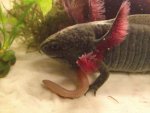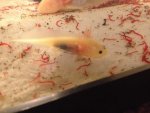SuburbanGirl
Member
- Joined
- Oct 24, 2013
- Messages
- 54
- Reaction score
- 5
- Points
- 8
- Location
- Dallas
- Country
- United States
- Display Name
- Keeper of Jacks
So I have 4 problems:
1. Giant Jack was eating his earthworm last night (it was a big one) and then half the worm started coming out behind his gills. I took a picture of it, but I was wondering if anyone can tell me if this is normal. I was feeling ill, so I went to bed shortly after I fed him, and this morning he was in his hide, so I don't know if he was able to resolve his issue with that. Is this normal? Should I have done something different? Am I the only one that thinks this looks gross?
2. I have a tank with little Jacks in it, and they were looking a little off on Monday. One of the albinos was very pink and I could almost see veins. I tested the water and my ammonia was 0 nitrate was .25 and nitrite was 40 ppm. I did a water change that day and tried to get as much of the **** up off the bottom that I could. I thought things were looking better. Why would my nitrAte spike when the tank was cycled before? Should I just keep changing the water until it is cycled again?
2.5 I upgraded giant Jack to a larger tank, but I didn't move his sand, just his filter and plants and decorations. There was a small ammonia spike that went away after one water change. Is this normal?
3. I tested the water again on Wednesday and the parameters had not changed, and the same albino Jack was looking really red and I could see his veins. I took him out of the tank and put him in a box with treated water and a little bit of food. I have been changing his water twice a day since then, and he looks a little less red, but I can still see some veins. He is still eating and pooping. How long should I keep him separated before I add him back to the other Jacks? Would adding tea to his water help?
4. Tiny Jack used to be in the same tank as the little Jacks, but he is about an inch smaller than them. My ex-husband was in the hospital for a week so I was spending a lot of time there. Because of this there was a day that I wasn't able to feed any of the Jacks. The next day when I looked at them tiny Jack had lost an arm. I decided to move him to a bowl so he can get more food. I am also changing his water twice a day, and in the last week his arm seems to be growing back. Do I need to do anything to help his arm grow back? Is there anything else I should look for that might cause problems while his arm is growing back?
I've tried to attach some pictures. The first one is Jack with a worm coming out his gills, the second is a very blurry pic of Jack with one arm. I know there are lots of bloodworms on the sand, I am using a pair of feeding jars, but sometimes some of them get out. I'm sorry about all the questions, but any help or thoughts would be appreciated.
1. Giant Jack was eating his earthworm last night (it was a big one) and then half the worm started coming out behind his gills. I took a picture of it, but I was wondering if anyone can tell me if this is normal. I was feeling ill, so I went to bed shortly after I fed him, and this morning he was in his hide, so I don't know if he was able to resolve his issue with that. Is this normal? Should I have done something different? Am I the only one that thinks this looks gross?
2. I have a tank with little Jacks in it, and they were looking a little off on Monday. One of the albinos was very pink and I could almost see veins. I tested the water and my ammonia was 0 nitrate was .25 and nitrite was 40 ppm. I did a water change that day and tried to get as much of the **** up off the bottom that I could. I thought things were looking better. Why would my nitrAte spike when the tank was cycled before? Should I just keep changing the water until it is cycled again?
2.5 I upgraded giant Jack to a larger tank, but I didn't move his sand, just his filter and plants and decorations. There was a small ammonia spike that went away after one water change. Is this normal?
3. I tested the water again on Wednesday and the parameters had not changed, and the same albino Jack was looking really red and I could see his veins. I took him out of the tank and put him in a box with treated water and a little bit of food. I have been changing his water twice a day since then, and he looks a little less red, but I can still see some veins. He is still eating and pooping. How long should I keep him separated before I add him back to the other Jacks? Would adding tea to his water help?
4. Tiny Jack used to be in the same tank as the little Jacks, but he is about an inch smaller than them. My ex-husband was in the hospital for a week so I was spending a lot of time there. Because of this there was a day that I wasn't able to feed any of the Jacks. The next day when I looked at them tiny Jack had lost an arm. I decided to move him to a bowl so he can get more food. I am also changing his water twice a day, and in the last week his arm seems to be growing back. Do I need to do anything to help his arm grow back? Is there anything else I should look for that might cause problems while his arm is growing back?
I've tried to attach some pictures. The first one is Jack with a worm coming out his gills, the second is a very blurry pic of Jack with one arm. I know there are lots of bloodworms on the sand, I am using a pair of feeding jars, but sometimes some of them get out. I'm sorry about all the questions, but any help or thoughts would be appreciated.


